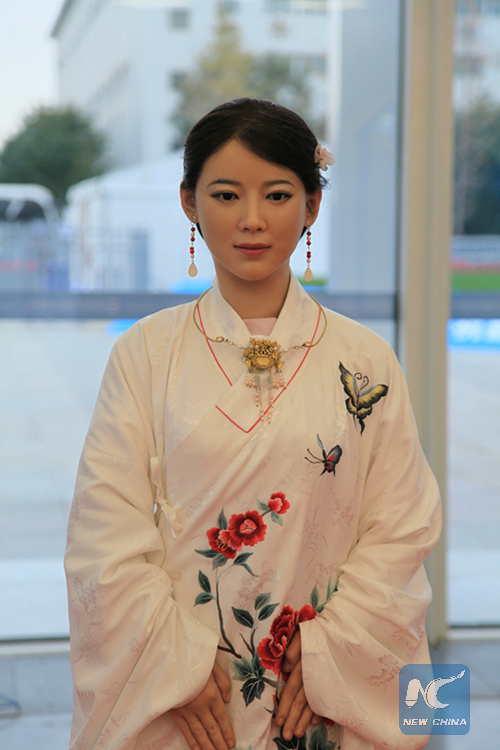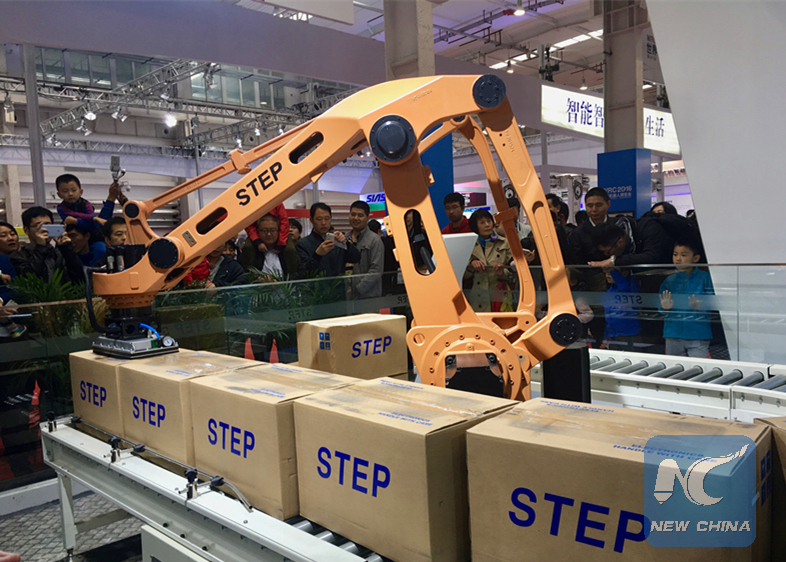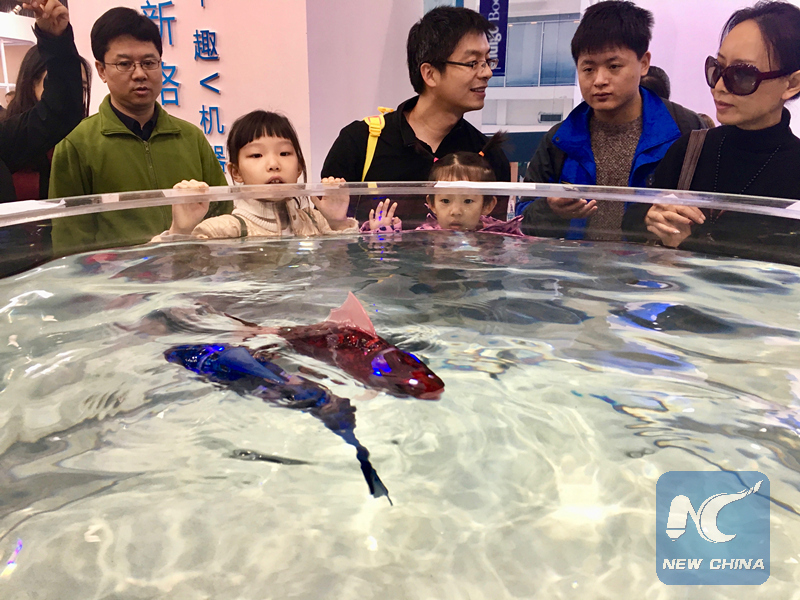
A robot replica of ancient Chinese philosopher Wang Yangming practices calligraphy at the 2016 World Robot Conference in Beijing, China, Oct. 22, 2016. (Xinhua/ Wang Yue)
BEIJING, Oct. 24 (Xinhua) -- You might have to look twice to make sure that what you saw is a robot rather than a real man. Clad in a dark blue gown practicing traditional Chinese calligraphy , the life-like robot is a replica of philosopher Wang Yangming who lived nearly 500 years ago.
Robot Wang Yangming writes attentively, nodding and moving its other arm from time to time, undisturbed by the large crowds surrounding it at the 2016 World Robot Conference in Beijing. Over 200 scientific research institutions and enterprises from all over the world came here to show off their latest robotic achievements. More than 300 experts from 11 countries also gathered here to share ideas during the 5-day conference and expo that would last until Tuesday.
The developer of Robot Wang Yangming said it can also interact with people.
A few steps away stands the famous "robot goddess" Jia Jia, China's first interactive robot. Dressed in a lavish traditional Chinese gown, the humanoid robot can make micro-expressions, roll her eyes, recognize facial expressions of others and converse with those who ask her questions, either in Chinese or English, within seconds.

Jia Jia, an interactive robot, stands in the venue of the 2016 World Robot Conference in Beijing, Oct. 22, 2016 ( Xinhua/ Wang Yue)
Jia Jia is the brain child of a team from the University of Science and Technology of China in east China's Anhui Province. The researchers said there are still space for improvements so that the "goddess" can have more facial expressions and interact more deeply with people.
With an aging workforce and rising labor costs, China is determined to drive robot development. According to statistics released by the Qianzhan Industry Research Institute, the output value of China's homegrown robots in 2015 stood at 1.64 billion yuan (243 million U.S. dollars), a year-on-year increase of 55 percent.

An industrial Robot moves boxes in front of a crowd at the World Robot Conference in Beijing, Oct. 22, 2016. (Xinhua/ Wang Yue )
At the conference, Vice Premier Liu Yandong also urged enhanced research and development of the industry.
Industrial robots are well represented at this year's expo. According to the organizer, industrial robots account for about 40 percent of all robots on display at the show, while the rest are service robots and specialized robots.
The Chinese market for industrial robots is huge. According to the China Robot Industry Association, 68,000 industrial robots were sold in China in 2015, up 20 percent from 2014. China accounted for about a quarter of robot sales globally in 2015, making the country the biggest market for industrial robots for three consecutive years.

An industrial robot demonstrates 3D printing at the 2016 World Robot Conference in Beijing, Oct. 22, 2016 (Xinhua/Wang Yue)
Meanwhile, 32,996 industrial robots were manufactured in China last year, up 21.7 percent year on year.

A robot of the Siasun Robot and Automation Corporation, which is developed to help locate tumors, simulates the use of a medical instrument on a model of a human skeleton at the World Robot Conference in Beijing, Oct. 22, 2016. (Xinhua/ Wang Yue)
The country wants to be able to make 150,000 industrial robots in 2020, 260,000 in 2025 and 400,000 by 2030. If achieved, the plan should help generate a market value of 600 billion yuan over the next decade.
Among the expo highlights are also service robots, which industry insiders say have been used in catering, education, banking services, government institutions and sports.

A service robot plays drums at the World Robot Conference in Beijing, Oct. 22, 2016 (Xinhua/Wang Yue)
Service robots have seen a rise in numbers at the show. Last year, they accounted for about 30 percent of all robots on display at the WRC, but this year the number has jumped to 35 percent, according to the organizer.

Children take interest in two robot fish, which can be used as underwater cameras, at the World Robot Conference in Beijing, Oct. 22, 2016. (Xinhua/ Wang Yue)
The government in April stepped up its effort to boost the industry, issuing a development plan for the next five years, which laid out the industry's five tasks, including key breakthrough in products and significant improvement of technical reliability.
Despite government support, challenges remain, as the Chinese market is still dominated by overseas products and homegrown companies have not mastered core technology, said Niu Nutao, a national lawmaker and an official in charge of the information sector in east China's Anhui Province.

